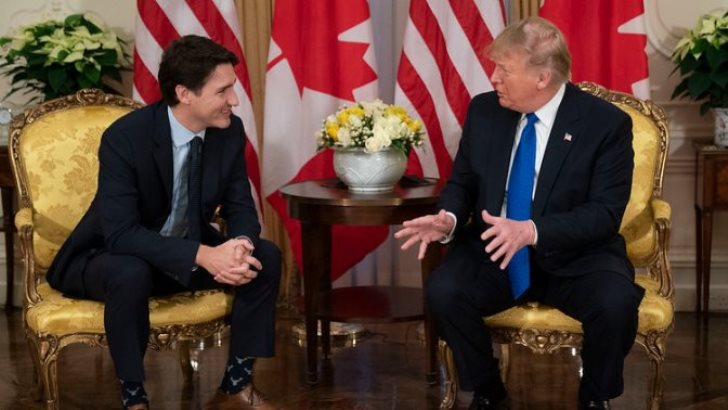
Following his re-election, former U.S. President Donald Trump reignited global trade tensions by aggressively targeting China with a new wave of tariffs. The renewed tariff war began shortly after his second term started, with the imposition of a 10% tariff on $200 billion worth of Chinese imports. Just a few weeks later, this was followed by another 10% on an additional $300 billion in goods. Trump also threatened to impose a 25% tariff on imports from Mexico and Canada, further shaking global confidence. Although these tariffs were repeatedly delayed and paused, the back-and-forth nature of Trump’s trade policy created massive uncertainty that spooked global markets, leading to significant corrections in equities, cryptocurrencies, and commodities.
The Tariff Escalation
In early February 2025, President Trump’s administration imposed an initial 10% tariff on Chinese imports, citing ongoing concerns about trade imbalances and China’s practices surrounding intellectual property theft and forced technology transfers. The Chinese economy, already grappling with domestic challenges, retaliated with tariffs of their own on U.S. goods, further escalating tensions. Within weeks, the U.S. government doubled down by adding another 10% tariff on a further $300 billion worth of Chinese products.
Adding fuel to the fire, Trump openly threatened to impose a 25% tariff on goods from Mexico and Canada, key trading partners under the USMCA (United States-Mexico-Canada Agreement). The market reaction was immediate and severe, as investors feared the effects of these tariffs on North American supply chains, which are closely intertwined. The threat of these additional tariffs caused market sell-offs, but the actual imposition was delayed several times, creating additional uncertainty. By the beginning of March 2025, the tariffs were briefly set to go into effect before being halted yet again in a last-minute policy reversal.
Global Market Fallout and the Correction Territory
Global financial markets were rattled by this erratic trade policy. Uncertainty in the business community, particularly around supply chains, led to a sharp decline in investor confidence. Stock markets entered a correction territory, defined as a 10% or greater drop from recent highs. The S&P 500, Dow Jones Industrial Average, and Nasdaq all declined more than 10% during the early months of 2025. Furthermore, U.S. indices began trading below their critical 200-day moving averages, a key technical indicator signaling further bearish sentiment among investors.
The decline was particularly sharp in technology stocks, often referred to as the "Magnificent 7," a group of tech giants driving market performance. Every one of these companies, with the exception of Meta (formerly Facebook), experienced significant declines. Leading the sell-off was Tesla, which saw its stock price drop by a staggering 45%. Tesla, heavily reliant on global supply chains and exposed to Chinese manufacturing and sales, was particularly vulnerable to the trade tensions between the U.S. and China. This sharp correction reflected the broader fear that the escalating tariff war would stifle growth for major corporations with international operations.
Cryptocurrency Correction: Bitcoin and Ethereum Dive
The uncertainty in traditional markets also extended to the cryptocurrency sector, where speculative assets like Bitcoin (BTC) and Ethereum (ETH) suffered massive corrections. By March 2025, Bitcoin had plunged below the $80,000 level, while Ethereum was trading under $2,000—both a significant fall from their highs in previous years. The rapid decline in cryptocurrency prices was partially driven by the broader sell-off in risk assets, as investors moved away from volatile markets due to fears of prolonged economic slowdown fueled by the tariff wars.
The threat of tariffs on imports of technology-related goods, particularly from China, was especially concerning for the crypto industry. China plays a critical role in the global supply of electronics and semiconductors, both of which are vital for cryptocurrency mining operations. The fear of higher costs, along with the uncertainty in global trade policies, dampened investor sentiment in the digital asset space.
Weakened U.S. Dollar and Crude Oil Prices
As the tariff war continued, the U.S. dollar began to weaken in response to expectations of slower economic growth in the U.S. due to the ongoing trade tensions. Analysts and economists had forecasted a deceleration in American economic growth for the rest of 2025, as tariffs raised costs for both consumers and businesses. This economic slowdown led to expectations of potential interest rate cuts by the Federal Reserve, which weighed on the U.S. dollar. A weaker dollar typically signals lower demand for U.S. goods in international markets, further complicating the trade deficit Trump sought to address.
In tandem, crude oil prices also saw a decline, reflecting broader concerns about global economic growth. The slowdown in the U.S. economy, combined with the trade war, stoked fears of reduced demand for oil. Despite attempts by OPEC to stabilize prices, oil dipped as investors priced in the potential for a sustained economic downturn. The energy sector, already facing headwinds from rising input costs due to tariffs, found itself in a challenging position as global demand forecasts were slashed.
Conclusion: Uncertainty Shakes Global Confidence
The tariff war initiated by Donald Trump in his second term created a ripple effect of uncertainty and volatility across global markets. The erratic implementation of tariffs on China, along with the looming threats of tariffs on Mexico and Canada, left investors unsure about the future of international trade. The result was a massive sell-off in equities, with major indices entering correction territory, and significant downturns in both cryptocurrency markets and commodities like crude oil.
As the U.S. dollar weakened and economic growth forecasts declined, the uncertainty surrounding trade policies became a critical challenge for businesses and investors. This period of unpredictability demonstrated how sensitive global markets are to shifts in trade policies, and how prolonged uncertainty can erode confidence in even the strongest economies. The lingering question now is how long these effects will persist and whether the global market will find stability in the face of continued geopolitical tensions.




















